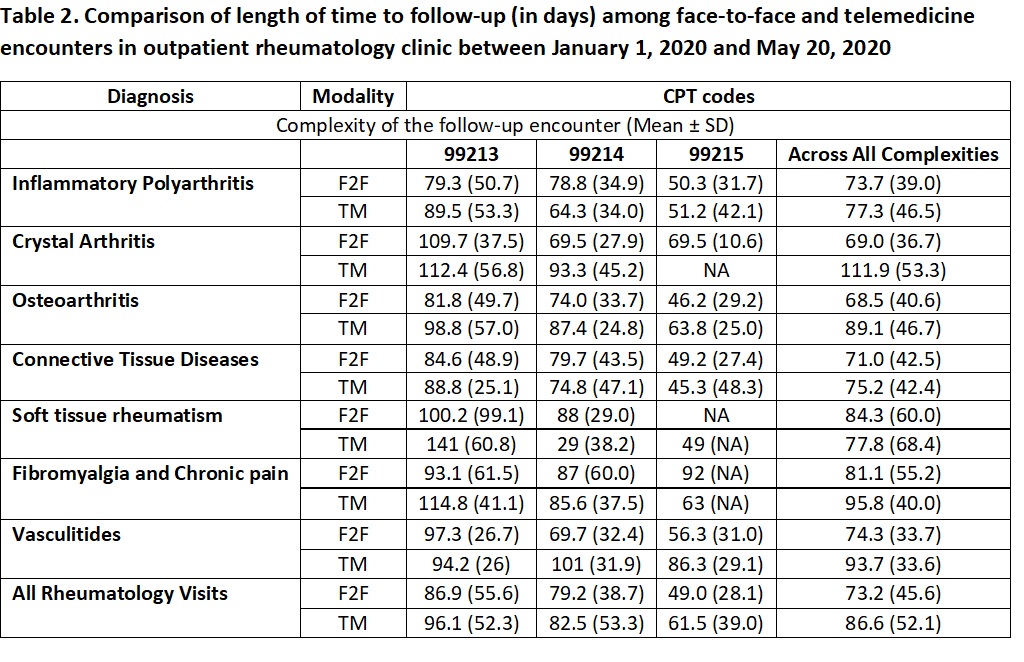Session Information
Session Type: Poster Session D
Session Time: 9:00AM-11:00AM
Background/Purpose: In the era of recent COVID-19 crisis, outpatient rheumatology practices resorted to telemedicine to deliver longitudinal care, a fundamental component of chronic disease management. However, little is known regarding time to follow up after telemedicine visits as compared to conventional face-to-face encounters as a marker of longitudinal care.
Methods: We used electronic medical records (EMR) data from 1/1/2020 to 5/20/2020 to capture all encounters in the outpatient rheumatology practice. On March 12, when Rhode Island approved telemedicine visits as payable by insurers, telemedicine visits were captured in EMR like face-to-face visits. For both telemedicine and face-to-face visits, we captured data for patient demographics, date of visit, key diagnoses addressed at the visit identified by ICD-10 billing codes, complexity of visit based on CPT codes and scheduled follow-up in rheumatology clinic. The CPT codes for complexity of visit were 99201 to 99215 for initial and subsequent visits by either modality of care. CPT codes unique to telemedicine were transformed into their equivalent CPT codes from 99201 to 99215 based on their time factor.
Time to follow-up was calculated as the difference between scheduled follow-up and date of the current visit and expressed in days. We assessed the variation in time to follow-up by reporting mean with standard deviation across key rheumatic diagnoses and complexity of visits. Due to non-normality of the distribution of follow-up time, the Mann-Whitney U test was used to compare differences of follow-up time between face-to-face and telemedicine encounters across rheumatic diagnoses and complexity of visits.
Results: A total of 2,356 visits were completed by the rheumatology division between 1/1/2020 and 5/20/2020, of which 621 (26.4%) were via telemedicine. There was higher uptake of telemedicine amongst women and older patients. Telemedicine encounters were billed lower CPT codes as compared to face-to-face encounters (Table 1). The follow-rate between the 2 groups was similar (30.8% v. 32.4%). The time to follow-up was longer with telemedicine visits as compared to face-to-face visit (86.6 ± 52.1 v. 73.2 ± 45.6 days, p< 0.01). This was also noted for encounters with higher complexity billing codes (Table 2).
Conclusion: In the face of COVID-19 pandemic, the follow-rate after telemedicine was similar to that of face-to-face encounter with longer follow-up time with telemedicine across all complexities of visits. While the fear of COVID-19 pandemic may be reason for this observation, it also suggests that telemedicine could be a useful adjunct to face-to-face visits for longitudinal care of patients with rheumatic illnesses.
 Table 1. Telemedicine uptake characteristics in outpatient Rheumatology clinic between January 1, 2020 and May 20, 2020 (N = 2,356 encounters).
Table 1. Telemedicine uptake characteristics in outpatient Rheumatology clinic between January 1, 2020 and May 20, 2020 (N = 2,356 encounters).
 Table 2. Comparison of length of time to follow-up (in days) among face-to-face and telemedicine encounters in outpatient rheumatology clinic between January 1, 2020 and May 20, 2020
Table 2. Comparison of length of time to follow-up (in days) among face-to-face and telemedicine encounters in outpatient rheumatology clinic between January 1, 2020 and May 20, 2020
To cite this abstract in AMA style:
Dalal D, Chu T, Crough B, Molino J, Hemendinger D, Ramratnam B. Average Follow-up Time After Telemedicine Visit Is Longer Than Conventional Face-to-Face Visit in Outpatient Rheumatology Practice During COVID-19 Pandemic [abstract]. Arthritis Rheumatol. 2020; 72 (suppl 10). https://acrabstracts.org/abstract/average-follow-up-time-after-telemedicine-visit-is-longer-than-conventional-face-to-face-visit-in-outpatient-rheumatology-practice-during-covid-19-pandemic/. Accessed .« Back to ACR Convergence 2020
ACR Meeting Abstracts - https://acrabstracts.org/abstract/average-follow-up-time-after-telemedicine-visit-is-longer-than-conventional-face-to-face-visit-in-outpatient-rheumatology-practice-during-covid-19-pandemic/
